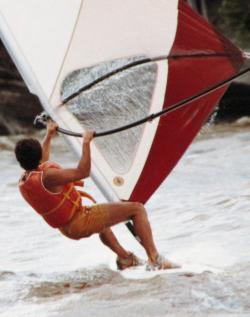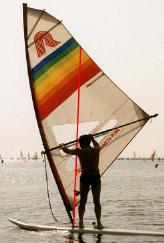
Tip 1: Don't fall down. A friend and college classmate, Martin Schrage, once described a ski lesson in which, as a student tried some maneuver, the instructor yelled, "Don't fall down! No, no, I told you, don't fall down!" While this advice doesn't seem particularly helpful, it is certainly true that when sailing a windsurfer, your first goal, the sine qua non of windsurfing, is to not fall down (not usually an issue on a regular sailboat). At first glance, this may seem like an issue of balance, in the usual sense of positioning your weight. But it is not. The forces involved are much too large to counter them by trying to throw your body around. Not falling down is indeed an issue of balance, but a different kind of balance: it's a balance of forces. A glance at the image above clearly shows the primary force: the force of the wind in the sail, which tries to pull you forward (that is, towards the sail). That's got to be countered by a force in the opposite direction, and there is only one way to generate that force: the weight of your body, leaning backward. This brings us to Tip 2: Tip 2: You must always be leaning backwards. Think about it: if your body ever becomes vertical, all backward force is lost, and the slightest tug on the sail will pull you over. One of the difficulties learners (not just sailors) have with windsurfing is developing the confidence to be leaning backwards at all times - the confidence that the sail will support you. Keep your back straight, and hang by the wishbone (the "wishbone" is the windsurfing equivalent of a "boom"). Tip 3: You control the tug of the sail. So what you need to do is to balance your weight leaning back with the force of the sail trying to pull you forward. But that's easy, since you have a "control knob" that lets you adjust the pull of the sail. If the sail tries to pull you over, turn the "control knob" down to reduce the pull, and your weight will draw you back. If you start to fall backward, turn the "knob" up to increase the tug, and you'll be pulled back up. Thus, you have no excuse for falling down! What is this "control knob"? Any sailor ought to know what it is: the position of the sail. Pull the sail "in" (flatten the sail), and it will catch more wind, increasing the force. Let the sail "out" (you can go so far as to let it luff), and you will decrease the force. Bingo! Nothing can go wrong! Tip 4: The sail need not be in proper trim at all times. This is one of those "sailors' prejudices" you need to get over: sailors want the sail to be properly trimmed at all times. As a windsurfer, you've got to get over that notion. The first thing you do with the position of the sail is balance the tug of the sail against your weight. The second thing you do is properly trim the sail for the direction you're going. Remember Tip 1: your first job is "Don't fall down". This is analogous to riding a bicycle. The first thing you do with the steering of a bicycle is to not fall down. If the bicycle starts to fall to the left, you must slightly turn the steering wheel to the left, which produces a righting force. It doesn't matter that you don't want to turn left - you MUST make a slight turn to keep the bicycle balanced. Actually, sailing a windsurfer is more like riding a bicycle in a cross wind, which could cause you to have to make frequent active corrections to stay erect. When sailing, whenever the wind changes, it alters the force balance. If the wind speed increases, your backward lean becomes insufficient, and you need to spill wind from the sail briefly to drop your body further back. If the wind speed drops, your backward lean becomes excessive, and you need to quickly flatten the sail to pull you up. Of course, if the wind instantaneously drops to nothing, there's not much you can do. Beginners on a bicycle wobble all over the place. But when you get good at it, the steering motions you make to keep from falling over become very small, and you are able to steer in the direction you want to go. The small balancing corrections become second nature, automatic. The same thing happens with a windsurfer. Eventually, the motions of the sail needed to keep your weight balanced with the pull of the sail become small and automatic, and the sail is in proper trim most of the time. Tip 5: The mast isn't stationary. Suppose you start to fall backward, so you need to increase the tug of the sail to pull you back up. To do that, you pull the sail "in", flattening it so it will catch more wind. Any sailor knows that pulling a sail in takes a great deal of force, and can be time consuming - on a larger sailboat, you might have to use a winch. But on a windsurfer, this operation can't be allowed to take very long. If you're beginning to fall backward, you need to very rapidly increase the force pulling you back up. A sailor new to windsurfing is inclined to mentally think of the mast as fixed, with the sail pivoting around it, like on a regular boat. He or she is apt to try to adjust the sail primarily with the aft hand, leaving the forward hand, up by the mast, pretty much fixed. But on a windsurfer, the mast is free to move in any direction around its pivot point on the hull. This means that you can flatten the sail with a combination of two motions: pull in with your aft hand, but push out with your forward hand. Air spills from the back of the sail to the front, and the motion can be made very quickly. It means the mast is moving away from you, but this is a windsurfer - the mast can do that.
But now suppose the sailor were to let go of his forward (left) hand. Then the forward portion of the sail would swing away. It would be somewhat constrained by the bottom of the mast, but there is nothing to stop the rest of the mast from swinging out and away. My point is that you can rotate the sail around that red line in either direction, without having to exert any force at all! In practice, when you let one side out, you usually pull in the other side, with a "push-pull" motion. Because air can "spill" from one side of the sail to the other, this takes very little effort, and can be done quickly. Tip 6: It's you and the sail. A sailboat is a boat with a sail. A windsurfer is a sail with a board. It's you and the sail. The board isn't that important - you can push it around with your feet. You do need to keep your feet along the centerline - if you step off to the side, the board will rotate ninety degrees around its centerline, and flip you into the water. But the important relationship is between you and the sail. Tip 7: To get started, throw yourself back. Windsurfing beginners have trouble getting started, because they try to pull in the sail gradually (pull it in a bit, lean back a bit, pull it in a bit more, lean back a bit more, etc.). This doesn't work, because it fills the sail first at the clew, way aft. This pushes the stern to the leeward side, turning the hull upwind, luffing the sail and bringing the whole operation to a complete halt. Actually, sometimes the momentum carries the bow across the wind, and you come about, leaving you standing on the wrong side of the sail, which is a recipe for a bath. The proper way to start is to throw your body back into space, and then quickly bring in the sail to catch your fall. This transitions you into sailing position in a fraction of a second. As in Tip 2, you need to develop the confidence to lean back first, knowing that you can use the sail to stop your fall. It takes some trial and error to know how much to lean back before catching yourself, given the strength of the wind, but this is what you must do to get off to a clean start. Conclusion You've now seen how this particular engineer analyzed and learned windsurfing. I hope these tips will help others with knowledge of basic sailing learn this challenging and exciting sport.   Note 1: The generic term for this sport is "board sailing", and the boat is a "sail board", or sometimes "sailboard". "Windsurfer" was the trademarked name of a particular manufacturer's boat. However, it now seems to be used generically. In German, noun phrases like "sail board" would always be run together into a single word. For instance, in German, a "kitchen clock" is a "küchenuhr", from the two words "küchen" (kitchen) and "uhr" (clock, related to "hour"). Although English is a Germanic language, we keep the words of our noun phrases separated, until the noun phrase becomes extremely common. Then we might actually start running them together, as in "sailboard", "crockpot", and so on. [return to text]  |

 Here's another way to look at it. In the picture to the right, I've drawn a red line approximately up the center of the sail, starting at the universal joint at the base of the mast. Suppose the sailor were to let go of his aft (right) hand. The aft portion of the sail would swing out, and the sail would end up luffing.
Here's another way to look at it. In the picture to the right, I've drawn a red line approximately up the center of the sail, starting at the universal joint at the base of the mast. Suppose the sailor were to let go of his aft (right) hand. The aft portion of the sail would swing out, and the sail would end up luffing.